|
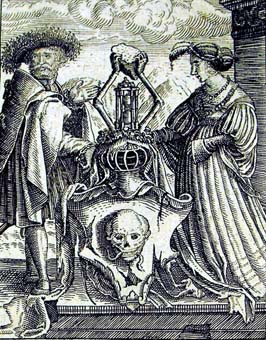
Kieser's Todten dantz dürch
alle Stände und
Geschlecht der Menschen,
(Gemmell 4)
|
Holbein's Dance of Death continued to grow in
stature and popularity, and with success came imitations. Gundersheiner writes
that in the 16th Century there were up to 100 unauthorized
editions and adaptations of his work, deducing: "It is evident,
then, that in these woodcuts, Holbein had designed a work of
enduring significance and appeal."
Marcia Collins points out that several Basel town guides
featured images that were ostensibly of the town's Dance of Death
murals, but that in fact owed more to Holbein's designs than the
actual murals. Other artists produced their own versions of
Holbein for publication, of varying quality.
|
|
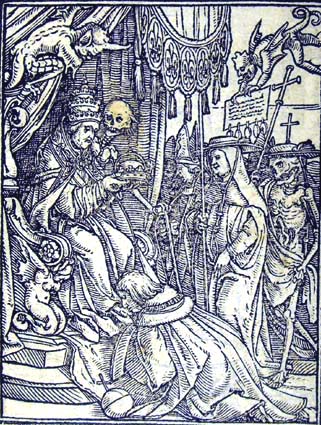
Holbein's Pope
illustration (Gemmell 1) |
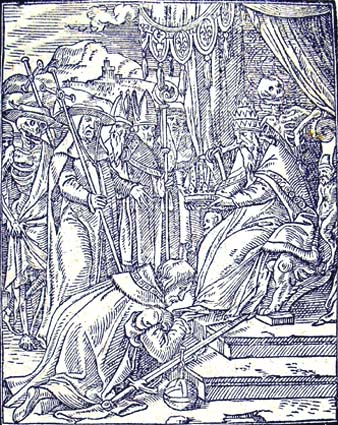
Nicolai's imitation, 1557 (Gemmell 2) |
|
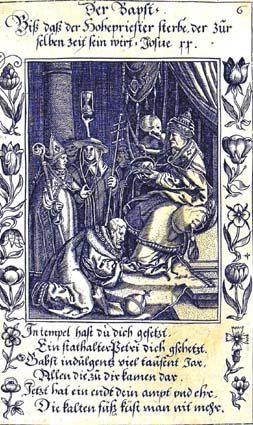
Kieser's imitation,
1618 (Gemmell 4) |
The two images above and that to the left compare Holbein's original designs with two
variations of the same scene.
Above, to the left, is Holbein's Pope; according
to Gundersheimer, this is a depiction of Leo X.
The illustration above right is from
Imagines mortis, published in Köln 19
years after Holbein's first edition, in 1557. Arnaud Nicolai
is generally attributed as the artist responsible for its 53
plates; it also features epigrams by Gilles Corroset (1510-1568).
It is clear that Nicolai took his designs straight from Holbein
and Lutzelburger. There is a little more detail in the background
of Nicolai's scenes - he adds in hills and clouds to provide
perspective in this example, for instance, but the flying demons
are absent. But possibly the most interesting deviation is that
Nicolai's scenes are reversed versions of Holbein's, perhaps
suggesting that they were carved directly from Holbein's images.
The illustration to the left is from a later Dance of Death by
Eberhard Kieser. Produced in the early 17th Century (c. 1618), it
also draws directly on Holbein. Again, the scene is reversed,
but the illustration is more finely detailed and an elaborate decorative border is added.
There is a crucial technical difference in the way this
illustration was produced, however: in this book, the illustrations are engravings made from metal plates rather
than the woodcuts of the earlier editions. Metal engravings
allowed artists to incorporate far more detail into their work. |
|
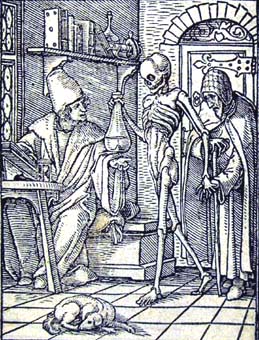
Holbein's physician (Gemmell 1) |
The popularity of the Dance of Death showed no signs of abating,
and as the 17th Century progressed, imitations continued apace.
W. H. Hollar (1607-1677) was an engraver who lived in Germany.
His adaptation of Holbein's Dance ran to many editions, even after
his death. The illustration shown to the right is taken from a
later hand-coloured edition of 1816. The scenes are accompanied by
descriptions of the action in both French and English.
Marcia Collins regards Hollar's work as one of the most skilful
17th-century imitators of Holbein. |
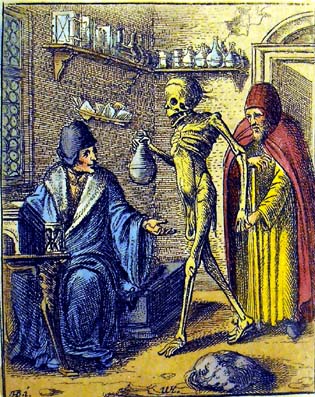
Hollar's physician (Gemmell 24) |
|
However, some artists did not slavishly
imitate Holbein's designs, but adapted his original
concept to their own ends. For example, Dutchman Salomon
van Rusting's early 18th Century interpretation of the
Dance of Death (dating from 1707, although the Special
Collections copy is a later 1741 edition) utilised some of
Holbein's scenes, but interspersed them with completely
new images. |
|
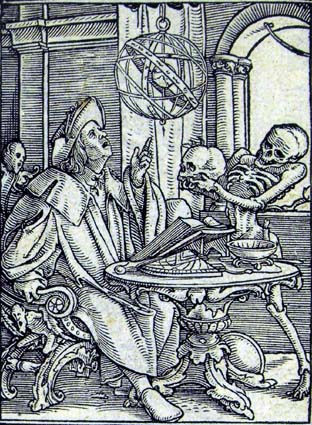
Holbein's astrologer (Gemmell 1) |
To the right is Rusting's version of
Holbein's astrologer (shown left). While the scene is
basically the same, the style of the metal engraving is far more elaborate than
the clean lines of Holbein's woodcut. |
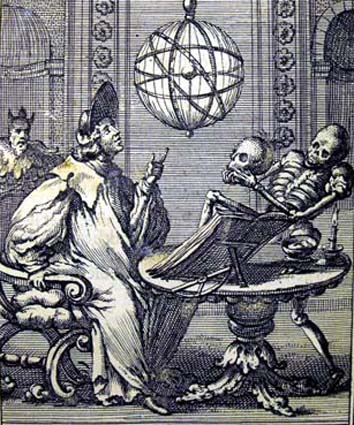
Imitation of astrologer scene (Gemmell 10)
|
|
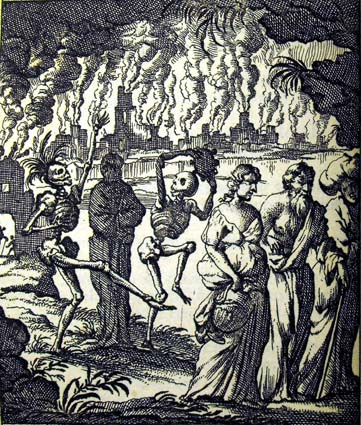
Gomorrah scene
from Van Rusting (Gemmell 10) |
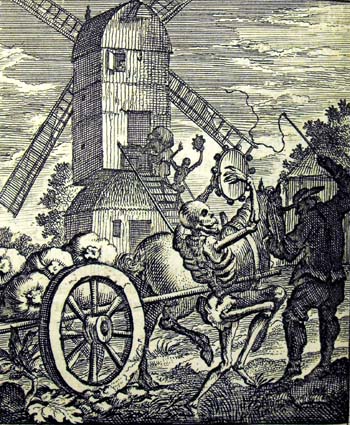
Windmill from Van
Rusting (Gemmell 10)
|
|
Rusting also supplemented his work with additional
Biblical scenes; he depicts the figure
of Death as being present at the great flood, at the slaughter of
children in Bethlehem, and at the sacking of Gomorrah
(shown above left). As the town goes up in flames in the
distance and its inhabitants flee, several figures of
Death rejoice, dancing with glee and shaking tambourines.
Rusting also created new scenes drawn from his everyday
life in Amsterdam. These include depictions
of skaters and circus acts, tightrope walkers, and above
right,
workers in the Dutch windmills. The skeletal death figures
once more provide musical accompaniment. |
|
|
Go to next section: Baroque Dances of Death
|